new posts in all blogs
Viewing: Blog Posts Tagged with: honeybees, Most Recent at Top [Help]
Results 1 - 7 of 7
How to use this Page
You are viewing the most recent posts tagged with the words: honeybees in the JacketFlap blog reader. What is a tag? Think of a tag as a keyword or category label. Tags can both help you find posts on JacketFlap.com as well as provide an easy way for you to "remember" and classify posts for later recall. Try adding a tag yourself by clicking "Add a tag" below a post's header. Scroll down through the list of Recent Posts in the left column and click on a post title that sounds interesting. You can view all posts from a specific blog by clicking the Blog name in the right column, or you can click a 'More Posts from this Blog' link in any individual post.
By: Arbordale Publishing,
on 6/18/2015
Blog:
(
Login to Add to MyJacketFlap)
JacketFlap tags:
butterflies,
Bats,
nature books,
honeybees,
pollen,
Special Days,
pollinators,
Achoo,
Arbordale Posts,
arbordale books,
pollinator books,
pollinator week,
special days of the year,
Add a tag
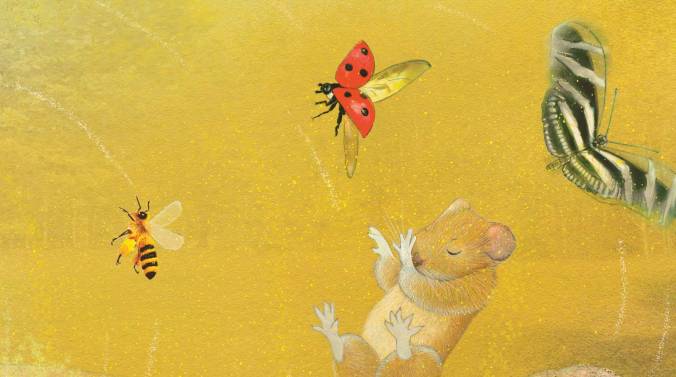 Where would the world be, if Baby Bear’s wish came true and all the pollen was to disappear? Well, many of his forest friends would be without food, and the bees and butterflies would have no reason to hop from flower to flower. That is why this week is pollinator week!
Where would the world be, if Baby Bear’s wish came true and all the pollen was to disappear? Well, many of his forest friends would be without food, and the bees and butterflies would have no reason to hop from flower to flower. That is why this week is pollinator week!
Why do we celebrate pollinators? These insects and animals are a vital part of our shaping our diet. Without pollinators many of the fruits and vegetables that we eat would not grow, not to mention… honey! The services of pollinators cannot be easily replicated by human farming practices and some plants, like almonds which are entirely dependent on honeybees would not be around anymore for us to enjoy.
In recent history, scientists have seen a drastic decline in the numbers of honeybees, monarchs and bats. Each of these species plays an important role in our lives. Whether it is the pollination of flowers by the monarch, bananas by bats, or blueberries by honeybees, humans are very reliant on pollinators and there are many things we can do to conserve these important creatures.
On Friday June 19th the Pollinator Week Festival is being held by the USDA on 12th Street in Washington DC! If you can’t make it to the nation’s capital, but would like to learn more, visit the pollinator site, and also read a few of Arbordale’s books about pollinators.


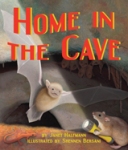
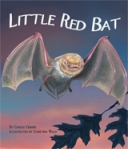


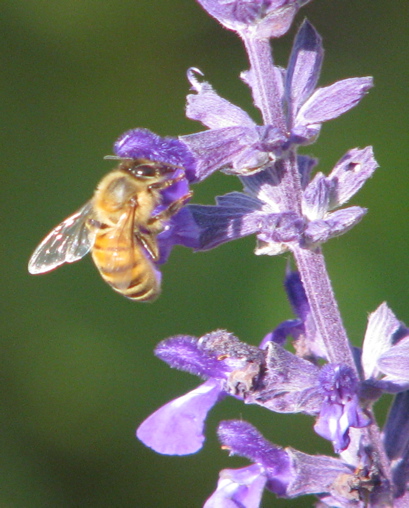
I know I’ve been singing this song for a long time, y’all, but it’s bad, bad, bad and getting worse.
Soaring Bee Deaths in 2012 Sound Alarm on Malady – NYTimes.com
“They looked so healthy last spring,” said Bill Dahle, 50, who owns Big Sky Honey in Fairview, Mont. “We were so proud of them. Then, about the first of September, they started to fall on their face, to die like crazy. We’ve been doing this 30 years, and we’ve never experienced this kind of loss before.”
When beekeepers and scientists first starting investigating colony collapse disorder, causes were uncertain. Rowan Jacobsen’s excellent book, Fruitless Fall, explores possible reasons. (Here’s one of my many posts about the book.)
Five years later, we have a much clearer idea of exactly what is happening, and it’s very bad news.
But many beekeepers suspect the biggest culprit is the growing soup of pesticides, fungicides and herbicides that are used to control pests.
While each substance has been certified, there has been less study of their combined effects. Nor, many critics say, have scientists sufficiently studied the impact of neonicotinoids, the nicotine-derived pesticide that European regulators implicate in bee deaths.
The explosive growth of neonicotinoids since 2005 has roughly tracked rising bee deaths.
Neonics, as farmers call them, are applied in smaller doses than older pesticides. They are systemic pesticides, often embedded in seeds so that the plant itself carries the chemical that kills insects that feed on it.
The pesticide is embedded in the seeds. I posted to another piece on this topic this last week, and these are just a couple of the many anxious reports I’ve picked up on my bee wire (Google Alerts, when they’re working) in the past few months. I know I’m probably preaching to the choir here, but I implore you to read up on this issue, if you haven’t yet, and to spread the word far and wide. If we lose the bees, we lose the world as we know it.
(Poetry Friday visitors, Miss Dickinson awaits you at the bottom of the post.)
I mentioned I’ve become hooked on beekeeping blogs ever since reading Fruitless Fall. Here are a few of my favorites:
Hive Mind Bee Blog. A backyard beekeeper in Washington. I especially enjoyed his account of a swarm in his neighborhood:
When they’re flying in the air, there’s nothing you can do but watch, but when the queen lands, the rest of the swarm will land around her in a huge, sedate clump that you can put into a bucket or a box and put back into a hive. Julie made a quick call to Dawn of the Puget Sound Beekeeper’s Association, got some info on how to proceed, and we were back in business. I threw on some overalls and my bee shirt, grabbed a bucket and a spatula, and I’s ready for action. First, though, I stopped off at the school across the street where kids and parents were doing landscaping and upkeep on the grounds and let them know that we had a science fair moment, if they were interested. A couple of the moms gathered up a dozen or so 5 - 10 yr olds and they all trooped over to see the bees.
Honey Run Apiaries. Great pictures, thoughtful discussion, wry observations.
I recently read an 1858 book ‘Phelps Bee-Keeper’s Chart‘. The book is obviously horribly out of date and out of print (though it is available on-line). Though it is interesting none-the-less for several reasons. While it does cover a lot about honey bees, much of it is for the purpose of promoting the authors patented ‘Ohio Combination Bee-Hive‘ saying that he expects it to ‘ supersede all others’. Sadly, while it apparently claimed honors at the Ohio and other state fairs, his book was published 6 years after Lorenzo Lorraine Langstroth’s book ‘The Hive and the Honey Bee’, which details the bee hive most of us use today in the US and in other parts of the world.
Fruitless Fall discussed the rise of the Langstroth hive, so that was a neat connection for us. Amusing tidbit at the bottom of that post:
The running joke is that if you ask 5 beekeepers in a room a question, you will receive 6 different answers. Apparently this is one of the oldest beekeeping jokes on record. Phelps wrote nearly 150 year ago that ‘there is scarcely any subject on which such a diversity of opinion exists, as on the form and size of bee-hives, and the general management of bees.’
Linda’s Bees might be my favorite beekeeping blog so far. She writes from Atlanta and posts the most incredible pictures, really informative shots that let you see the action inside a hive. Her hives have fun names like Bermuda and Mellona (the Roman goddess of bees). Excellent sidebar full of links we’re exploring as time permits.
We rented this NOVA film about bees: Tales from the Hive. The cinematography was fairly stunning. The corresponding website has video of the different bee dances and an interview with the filmmaker about how he managed the breathtaking closeup shots of bees in flight.
The next step was to find out how I could fly with the bees, because they are fast. I told myself, if I can’t fly with the bee, then the bee has to fly with me—that is, with the camera, directly in front of the lens. It was like the work at a clockmaker’s. We used a pair of tiny tweezers to form a wafer-thin wire. We then tied the bee up with this—very carefully, because we did not want to harm the bee, and we wanted to make sure it had the freedom to move its wings. A special kind of arrangement enabled us to fix the wire to the camera.
The film was made in 2000, before the beginning of bee colony collapse and I think possibly even before the massive varroa infestation that has crippled so many hives in recent years.
My dear daddy sent me some cool links:
How to make a house for mason bees
Pursuit of the perfect pollinator
(Thanks, Dad!)
Since today is Poetry Friday, let me leave you with a little Emily Dickinson.
The Bee
Like trains of cars on tracks of plush
I hear the level bee:
A jar across the flowers goes,
Their velvet masonry
Withstands until the sweet assault
Their chivalry consumes,
While she, victorious, tilts away
To vanquish other blooms.
Her feet are shod with gauze,
Her helmet is of gold;
Her breast, a single onyx
With chrysoprase, inlaid.
Her labor is a chant,
Her idleness a tune;
Oh, for a bee’s experience
Of clovers and of noon!
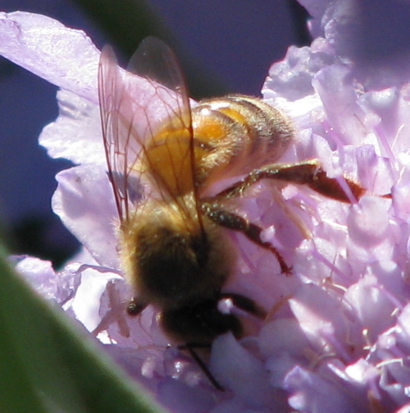

By:
Melissa Wiley,
on 5/13/2009
Blog:
Here in the Bonny Glen
(
Login to Add to MyJacketFlap)
JacketFlap tags:
bee colony collapse,
Books,
Links,
Fun Learning Stuff,
bees,
Nature Study,
honeybees,
Clippings,
Fruitless Fall,
Add a tag
As you know, I’ve had bees on my mind for weeks. I keep talking about Fruitless Fall, the book about bee colony collapse written by my former grad-school classmate, Rowan Jacobsen.
How much have you read about bee colony collapse?
I knew the honeybee’s numbers were declining. I remember hearing the wacky cell phone theory several years back, and that was laughed out of the news, and since then I’ve just heard ominous mutterings now and then about the bees disappearing and nobody knows why.
But I didn’t know the half of it.
I didn’t know, for example, that nowadays U.S. beekeepers earn most of their income—far more than they earn selling honey—trucking their hives around the country to pollinate crops. Somehow this gobsmacks me. We are dependent on migrant worker bees for the produce we grow in this country.
I definitely didn’t know that in the winter of 2006/2007, about a third of these hives died, and no one is sure exactly why. There are theories, which is a lot of what Rowan’s book is about: an in-depth and thoughtful exploration of what could possibly be causing the collapse of our bee colonies.
As I said above, when I heard about “the disappearance of the honeybee” I thought it meant declining numbers. Pesticides, I assumed (and indeed that seems to be a major factor). What I didn’t get was that bees literally disappeared. The hives died because the worker bees flew out and didn’t fly back home. There are diseases and pests that kill bees, and you find dead bees in and around the hive. (That’s happening too, in horrifying numbers.) But in other cases, the bees just up and disappeared. One possible reason, according to Rowan, is a kind of disorientation and memory loss known to be a symptom of neurological damage caused by certain pesticides. It’s highly likely the bees are suffering from something like Alzheimer’s due to exposure to toxins meant to kill other insects. They fly off to work and can’t find their way back home. And in other hives, there are bees carrying every bee disease, fungus, and pest known to afflict the honeybee world—all at once. It’s as if their immune systems have been decimated (possible cause: the catastrophic wave of varroa mite infestation that arrived in this country a few years back and is a terrible scourge in many parts of the world right now), leaving them susceptible to other illnesses.
And it isn’t just the honeybees: we know a lot about the decline in their numbers because they are domesticated bees, owned by devoted beekeepers who know exactly how many hives they have lost to varroa and bee colony collapse. No one has good numbers on all the other pollinating insects out there, except it seems clear honeybees aren’t the only pollinators in decline. Did you know vanilla beans are hand-pollinated by humans? The insect pollinator has been wiped out.
Obviously Fruitless Fall made a big impact on me. Shook me up; Jane too. The funny thing is, at the very same time that it was scaring the pants off me (a world short on pollinators is a scary, scary concept), it was filling me with wonder and delight. I know that sounds impossible. It’s the way Rowan looks so closely, with humor, warmth, and affection, at this ordinary (extraordinary!) creature, the honeybee. It reminded me of the John Stilgoe book I kept raving about last year, Outside Lies Magic. Remember that one? What Stilgoe did for me with power lines and telephone poles, Rowan Jacobsen did for me with bees and honey and even figs. The early chapters describing life in a beehive and the life cycle of the bee were so engaging that I read them aloud to Beanie, who was captivated. Jane has read the book at least three times now. She begged me to order Rowan’s book on chocolate—along with our very own copy of Fruitless Fall. Which is a good thing, because I find myself wanting to thrust the book at everyone I talk to. It’s that kind of book.
Monday, an article in the New York Times confirmed the story that the Barnes & Noble on Astor Place in New York is closing, and put to rest the rumors we'd been hearing that a new branch would open in Chelsea. The Astor Place branch will close on December 31, citing astronomical rents, the bane of all bookstores in NYC. (Strangely, the quoted yearly rent of $1.15 million for 32,000 square feet works out to only about $35 per square foot -- well within reasonable range, even for a bookstore.) The Times reports that a new B&N will open at 270 Greenwich Street in TriBeCa on November 28, "so the total number of Barnes & Noble stores will be unchanged."
However, a Tuesday article in the New York Post makes that last statement questionable. Real estate sources say that the Chelsea Barnes & Noble won't renew its lease when it comes up next May, though Barnes & Noble hasn't confirmed this. But the Post also says the chain may have signed a lease at Lexington Avenue and 86th Street for a new store to open next year. Go fig.
Possibly the best part of the Times story is two paragraphs at the end, where Meg Smith of the ABA offers McNally Robinson as a counter-example to the gloom-and-doom of the bookstore news. But read through the comments on the article for almost every possible perspective on the issue, from optimism that perhaps this signifies a return to local retail, to despair that New York is becoming ever more unaffordable and homogenized, to apathy about the importance of bookstores at all, and a brief debate about whether McNally Robinson is in fact a chain (it isn't; see comment #33). Fascinating stuff, and far from simple.
And then, check out the Tuesday Daily News story on independent bookstores in Brooklyn, which are thriving despite competition from Barnes & Nobles in their area. BookCourt (Boerum Hill), A Novel Idea (Bay Ridge), P.S. Bookshop (Dumbo), and Spoonbill and Sugartown (Williamsburg) are doing just great, actually. (And of course this brief article doesn't cover half the indie bookstores in the borough.).
Three New York papers; two days; three articles about bookstores. It's an interesting moment, folks.
Link Madness (late edition)
I guess I was overcome by Labor Day laziness and forgot to blog on Monday, so here are some late and rather eclectic links.
* Author Alex Kuczynski has a somewhat smirky article in the NY Times about the contemporary book party, describing the "colossal blowouts" for books by Tina Brown, Holly Peterson, and Patricia Marx, as opposed to the warm-wine-and-skimpy-brie affairs of yesteryear. Her contention is that today's parties are hosted not by publishers, but by wealthy authors and friends of authors; hence the extravagance in hopes of garnering publicity. (Thanks to Ron at Galleycat for the link, and I'll second his notion that if it's media mentions you want, invite a blogger or two along with the glitterati!) I'm not sure I agree with Kuczynski; we've hosted some pretty swanky publisher-sponsored digs at the bookstore, and sold books offsite at several more, though there are still plenty of author-sponsored cheap wine and cheese soirees -- long may they live.
* Speaking of rich people and reading, the Times also has a slideshow of recommended wedding gifts for booklovers. Too bad this wasn't around when the ALP and I were sending out invites -- though some of these are pretty silly. We're happy with just books... or maybe some more bookshelves.
* Here's a more grassroots kind of project: the Delocator! Covered recently in Bookselling This Week (among others), the website is a tool for locating independent coffee shops, movie theaters, and bookstores in your zip code, and anyone can add a favorite. It's not a perfect system (I put in McNally Robinson's zip code and several bookstores were in there two or three times, and there were clearly some spam entries), but it's certainly a step in bring independent businesses into the internet age, and raising consciousness of the great stuff in our own communities. Give it a try -- add your favorite local spots, and discover some new ones (I just added Word, one of the newer additions to the Brooklyn bookstore scene).
* Latest in the e-book saga: Business Week reports on the Sony Reader, which is available in Borders and Best Buy, though Sony won't release sales figures, which suggests it's not doing so well. The main problem at this point, aside from some complaints about clunky design, is that e-books for the readers are only available through Sony Connect, the company's own website, and there aren't that many. Though that may change as Sony is "now planning to adopt e-book software from Adobe Systems" which will allow downloads from other outlets. What do you think, readers (small R)? Any interest in reading books on an electronic device, particularly this one? What would have to happen to make e-books relevant? And what would that mean? I love the way one commentor on this article puts it:
I am interested in where this takes us? How many trees can we save? How do authors fare or royalties when the print and production is taken out? how much cheaper can books be? They're big questions. Bring them on!
* I know one place people will be talking about these questions: the 2008 ABA Winter Institute in Louisville, Kentucky! Registration has just been opened for the January 24-27 conference and educational sessions -- it's the third annual Winter Institute, so Len Vlahos at ABA has dubbed it WI3, perhaps in reference to the increasing focus on technology. Holy cow, am I dying to go. I'll have to figure out some way to beg, steal or borrow plane and hotel fare to get in on those conversations.
Brooklyn Bookstore Visits
I had a very interesting week. I'm in the home stretch of trying to get my business plan ready for the September 14 PowerUp! deadline, and as usual at this point I feel both super-ready and like I need to go back to Square 1. So I spent some time this week visiting folks at two different (successful) Brooklyn bookstores to pick their brains a little, and enjoy the scene.
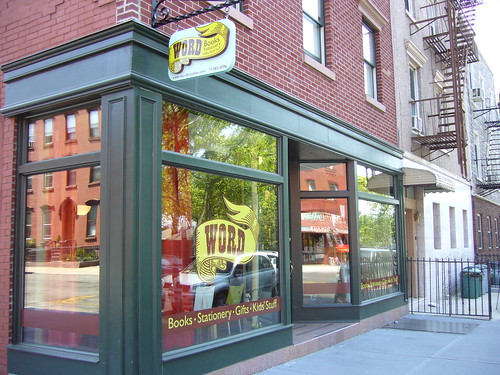 Word Books, Greenpoint
Word Books, Greenpoint
As I mentioned earlier, Word Books is one of the newest additions to the Brooklyn literary scene. Opened in March 2007 by Christine Onorati, it sits on the most Brooklyn-ish corner of Greenpoint you can imagine. Across the street is a public park with baby strollers and teenagers playing basketball; behind that is an old industrial warehouse with "GREENPOINT" stenciled in beautifully faded letters on the side; down the street is a church steeple silhouetted against the sky; a block away is the multi-lingual bustle of Greenpoint Avenue. Word occupies one of those enviable two-exposure corner lots, albeit on a quiet street in a neighborhood that's really only accessible by the dreaded G train (one of the few subways that only serves Brooklyn and Queens, not Manhattan, it's notoriously unreliable on weekends).
I asked Christine about that, expecting to hear that her business was mostly during the evenings and weekends when folks were home from work, but her knowledge of the neighborhood put my assumptions to shame. As she's discovered living a few blocks away, there are a lot of work-at-home folks around, and they are thrilled for the chance to shop local. The shop is open from 10 to 7, and business has been tripping along steadily for these first, often precarious months. To put it in perspective, Christine told me that she ran a bookstore in a small Long Island town for about six years ("practice" for the Brooklyn store, she calls it now), and while her rent in Brooklyn has doubled what she paid there, her sales have quadrupled -- and that's just in the first six months! She emphasized the importance of knowing your neighborhood, and knowing that there are folks who want to read what you read around you -- otherwise, she says, what's the fun of stocking your store?
The store has the aura of doing small things solidly and well. The window has a beautiful stencil with the store's name and specialties, and the window displays have won prizes (i.e. the Lonely Planet display contest). There's a graphic novel section that's possibly better than the one I buy for, though half the size. Discounted books are front and center; great fiction and nonfiction line the left-hand wall. A gorgeous display of hand-selected stationary and a wall of neat locally designed T-shirts round out the sideline offerings. And the back is a slightly segregated section of kids books and toys -- very savvy from a browsing and marketing perspective.
There's also great potential for the future. A child-proof gate blocks access to the basement, which is finished just enough to hold events (the store's Harry Potter party attracted around 200 locals). Christine has plans for expanding her event series, implementing a number of book clubs, and maybe adding more retail space. Talking to her, I suddenly realized the wisdom of thinking about a bookstore in phases. Maybe you don't have to have every element in place on opening day. Maybe it's financially and even emotionally more reasonable and satisfying to think of the store as a work in progress, something that will continue to improve and expand and refine and grow every month and year. I'm grateful to Christine for her insights, and I can't wait to see how Word continues to grow.
 Book Court, Boerum Hill
Book Court, Boerum Hill
Downtown Brooklyn's own BookCourt is at the other end of the spectrum in terms of bookstore life: founded in 1981, the store has done a fair amount of growing already, though more is on the horizon. I stopped in on a Friday morning to get a feel for the place and talk to founders Henry Zook and Mary Gannet and their son Zack, who now works in the store as a manager. The store is one of the success stories of indie bookselling in the last quarter of the 20th century: though they had some slow years in the 1990s, when the book business seemed to falter everywhere, their neighborhood regulars never failed them, and the owners were able to buy their original building and the one next door. Mary told me that when the Barnes & Noble opened a few blocks away in 2003, business at BookCourt actually got better. By that time folks had seen what tended to happen to small bookstores when the chains moved in, and they clearly told the owners of BookCourt that they weren't going to let that happen to their store. Mary and I agreed that Brooklyn is a good place for an indie: New Yorkers can tend to be more educated about economics and the effects of shopping local, and Brooklynites often have fierce loyalties to their neighborhoods.
BookCourt's operations were interesting too; they're open until around 11 most nights, because of the restaurants and nightlife in the area, and earlier in the morning to accomodate business from the nearby courthouses and city government buildings. I spent an hour or so receiving a shipment from Perseus (something I haven't had a chance to do in a long time), and learned about the store's staffing, computer systems, and discounting policies, which seem to fall somewhere between those of a small store and a large store, in keeping with the bookstore's 1800 square foot space. This encompasses the two store fronts and basement of the first building, and the store seems larger than it is, with lots of beautiful displays, staff picks, and local Brooklyn interest books. They're the exclusive seller of a Jonathan Lethem project, Patchwork Planet, and have lots of great relationships with local authors.
Things are about to change, though. Henry and co. are in the process of building on an addition in back that will more than double the size of the store, and that will serve as expanded event space, cafe, and increased retail space. To accommodate this increased volume, they're also finishing some basement space to serve as a receiving room and offices, and will streamline some processes. More books will be moved upstairs, the children's section will be relocated and expanded, and the store will begin to stock remainders. It's an exciting time, as the renovations should be complete in a few months, and the venerable store will enter a new phase of its life.
I sat with Henry and Zack in their office/living space above the bookstore after my stint on the floor, talking about history and future, plans and precautions. BookCourt is another shining example of knowing your neighborhood, investing wisely, and creating a space for books and authors that has obviously led to long-term success. I'm grateful to Henry, Mary, Zack, and their staff for their enthusiastic support of my own bookstore dreams, and inspired by the life they have created for themselves, and I look forward to seeing the bookstore continue to mature.
 Where would the world be, if Baby Bear’s wish came true and all the pollen was to disappear? Well, many of his forest friends would be without food, and the bees and butterflies would have no reason to hop from flower to flower. That is why this week is pollinator week!
Where would the world be, if Baby Bear’s wish came true and all the pollen was to disappear? Well, many of his forest friends would be without food, and the bees and butterflies would have no reason to hop from flower to flower. That is why this week is pollinator week!







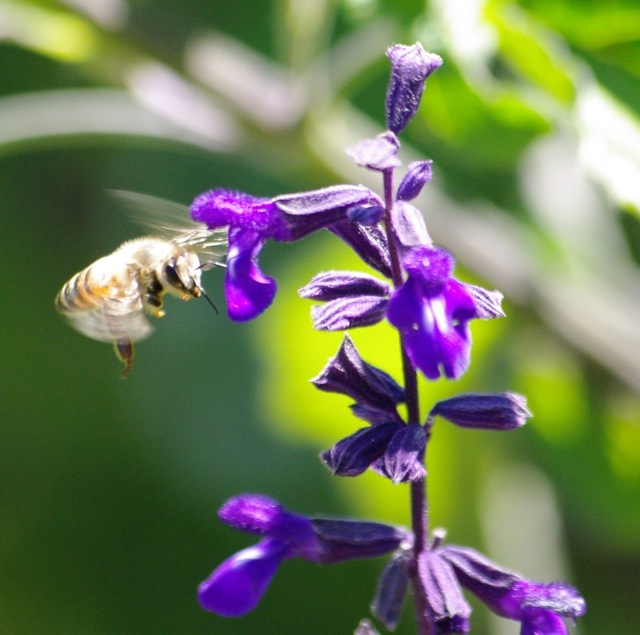




I don't generally read (or trust) the Post, seemingly for good reason. There is already a B&N @ 87th & Lex. Then again, they may be planning to close that & move into the new super-condo-scraper now under construction on the SE corner of 86 & Lex.
John T
As I understand it B&N is closing the 86th/87th & Lex store AND the 86th/2nd-3rd Ave. store and consolidating them in a larger store in the building that is now going up.
Makes sense. Just after I sent my comment I realized I'd forgotten about the B&N between 2nd & 3rd & had the same thought of consolidation strategy. --J